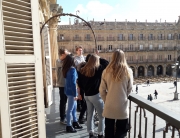Everybody in Spain knows that the celebration of San Fermín is celebrated the 7th of July. For those of you who didn’t know, you can check this famous and memorable song that won’t let you forget the celebration’s date. With this song you will also learn the days of the week and the numbers in your Spanish Courses 🙂 .
Even thou this date is famous, not many people know that the event hasn’t always been celebrated on July. For them, and for those of you who don’t know the meaning of these amazing festivities we are going back to the origins.
First documented testimonies lead us to the 14th Century and ever since this celebration has accompany the people from Pamplona, which is the city where Sanfermines happens. And the spirit and essence of the festivities has remain the same as well: gather pamploneses around “los toros” to establish commercial and fraternal relationships with their neighbours under the protection of San Fermín. In 1591 the citizens of Pamplona, tired of the rainy days of October -when originally the festivities had place- decided to move the celebration to the summer days making it coincide with three other important events: trade fairs, bull running (encierros de toros) and the homages for San Fermín.
But, why is this Saint so important? The history goes back to the 3rd Century when the romans were in the Peninsula. Fermín was the son of an important Senator –Firmo- who converted to Christianism at that time. He also baptised his son, Fermín in the very famous “pocico de San Cernin”. He became a priest in Toulouse and years later he came back to Pamplona to spread the Christian faith.
Nowadays this Celebration brings thousands of people from all over the world to participate on the events, and many of them are famous. But probably not as much as a very important writer: Hemingway who was passionate about Sanfermines. He came many times to be a part of the party and he wrote many books about the city and its people and tradition.
So don’t forget! , If you want to learn more about San Fermín, you can do it by the hand of this great writer 🙂 .
Y… ¡qué viva San Fermín!







